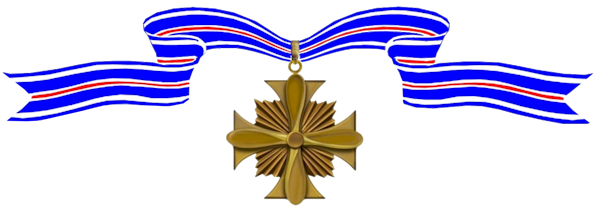Curtis LeMay was commissioned in the Army Air Corps in 1928 through the Reserve Officer Training Corps program at Ohio State University. After serving in the Army Air Forces in World War II, he transferred to the U.S. Air Force when it became a separate branch of service in 1947. From 1957 to 1961 he served as the 5th Vice Chief of Staff of the Air Force, and from 1961 to 1965 as the 5th Chief of Staff. He retired in 1965 as a U.S. Air Force 4-Star General, and ran as George Wallace’s Presidential running-mate in the 1968 Presidential Election, losing to Richard Nixon.

–
Cemetery:
Awards Received
-

Army Distinguished Service Medal
-

Air Force Distinguished Service Medal
-

Army Distinguished Service Medal
-

Silver Star
-

Distinguished Service Cross
-
Army Distinguished Service Medal
Service:
United States Army Air ForcesRank:
Major GeneralAction Date:
August 1944 – January 1945
War Department, General Orders No. 64 (August 4, 1945)The President of the United States of America, authorized by Act of Congress July 9, 1918, takes pleasure in presenting a Bronze Oak Leaf Cluster in lieu of a Second Award of the Army Distinguished Service Medal to Major General Curtis Emerson LeMay (ASN: 0-17917/A), United States Army Air Forces, for exceptionally meritorious and distinguished services to the Government of the United States, in a duty of great responsibility directing B-29 heavy bombardment activities of the 20th Bomber Command in the China-Burma-India Theater; and Subsequently as Commander of the 21st Bomber Command with headquarters on Guam from August 1944 to January 1945. The singularly distinctive accomplishments of Major General LeMay and his dedicated contributions in the service of his country reflect the highest credit upon himself and the United States Army Air Forces.
-
Air Force Distinguished Service Medal

Department of the Air Force, General Orders No. GB-273 (July 10, 1965)(Citation Needed) – SYNOPSIS: The President of the United States of America, authorized by Act of Congress July 9, 1918, takes pleasure in presenting a Second Oak Leaf Cluster in Lieu of a Third award of the Air Force Distinguished Service Medal (Army Design) to General Curtis Emerson LeMay (ASN: 0-17917/A), United States Air Force, for exceptionally meritorious and distinguished services to the Government of the United States, in a duty of great responsibility, culminating as Chief of Staff of the Air Force from 1961 to 1965. The singularly distinctive accomplishments of General LeMay culminate a long and distinguished career in the service of his country and his dedicated contributions reflect the highest credit upon himself and the United States Air Force.
-
Army Distinguished Service Medal
Service:
United States Army Air ForcesRank:
Major GeneralAction Date:
June 1943 – June 1944
War Department, General Orders No. 82 (October 18, 1944)The President of the United States of America, authorized by Act of Congress July 9, 1918, takes pleasure in presenting the Army Distinguished Service Medal to Major General Curtis Emerson LeMay (ASN: 0-17917/A), United States Army Air Forces, for exceptionally meritorious and distinguished services to the Government of the United States, in a duty of great responsibility from June 1943 to June 1944. The singularly distinctive accomplishments of Major General LeMay and his dedicated contributions in the service of his country reflect the highest credit upon himself and the United States Army Air Forces.
-
Silver Star
Service:
United States Army Air ForcesRank:
Colonel (Air Corps)Regiment:
4th Bomb WingDivision:
8th Air ForceAction Date:
World War II
Headquarters, 8th Air Force, General Orders No. 35 (March 26, 1943)(Citation Needed) – SYNOPSIS: The President of the United States of America, authorized by Act of Congress July 9, 1918, takes pleasure in presenting the Silver Star to Colonel (Air Corps) Curtis Emerson LeMay (ASN: 0-17917/A), United States Army Air Forces, for gallantry in action against the enemy while serving as Command Pilot of a B-17 Flying Fortress Bomber of the 4th Bomb Wing, 8th Air Force, in aerial operations in the European Theater of Operations, in 1943. The gallant actions and dedicated devotion to duty demonstrated by Colonel LeMay, without regard for his own life, were in keeping with the highest traditions of military service and reflect great credit upon himself and the United States Army Air Forces.
-
Distinguished Service Cross
Service:
United States Army Air ForcesRank:
Brigadier General [then Colonel (Air Corps)]Regiment:
4th Bomb WingDivision:
8th Air ForceAction Date:
August 17, 1943
Headquarters, European Theater of Operations, U.S. Army, General Orders No. 94 (December 8, 1943)The President of the United States of America, authorized by Act of Congress July 9, 1918, takes pleasure in presenting the Distinguished Service Cross to Brigadier General [then Colonel (Air Corps)] Curtis Emerson LeMay (ASN: 0-17917/A), United States Army Air Forces, for extraordinary heroism in connection with military operations against an armed enemy while serving as Pilot of a B-17 Heavy Bomber and Commander of the 4th Bomb Wing, EIGHTH Air Force, while participating in a bombing mission on 17 August 1943, against enemy ground targets in the European Theater of Operations. General LeMay, fully realizing the extent of the hazards involved, although not required to participate through obligation or reason of duty, undertook the responsibility of directing this mission. In spite of heavy enemy fighter attack and antiaircraft fire, General LeMay led the formation to target, accomplished his mission, and led the return to a friendly base. His courage, coolness, and skill on this occasion were an inspiration to his men and reflect great credit upon himself, the 8th Air Force, and the United States Army Air Forces.


